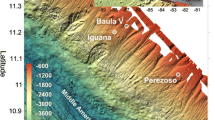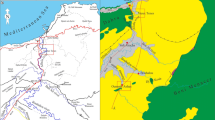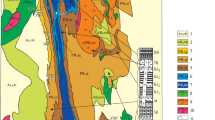Abstract
Authigenic carbonates from outcrops of the northern Apennines consist of small and irregular lenses and exhibit numerous features indicative of cold-seep settings. Detailed petrographic, mineralogical and geochemical studies from two Miocene deposits are presented. The first carbonate outcrop, named Fosso Riconi, is located in the foredeep basin of the Apenninic chain, whereas the second deposit represents a satellite basin called Sarsetta. The stable isotope data from specific carbonate minerals show a wide range of values well known from other palaeoseeps of the Apennine Mountains. The majority of seep carbonates are formed by low-Mg calcite and ankerite. Those minerals have δ13C values between −7 and −23‰ V-PDB, suggesting variable amounts of carbonate derived from oxidized methane, seawater (dissolved inorganic carbon) and sedimentary organic matter. Dolomite samples have the lowest δ13C values (−30.8 to −39.0‰ V-PDB), indicating methane as the main carbon source. The findings suggest an evolutionary formation of the seeps and development of authigenic carbonates influenced by the activity of chemosynthetic organisms, of which large lucinid clams are preserved. Bioirrigation by the clams controlled the sediment–water exchange, and is here considered as an explanation for the anomalous Mg content of the calcite. We hypothesize that the seep carbonates were formed during periods of active methane-rich seepage, whereas during periods of slow seepage carbonate formation was reduced. Despite different geological settings, the two examined deposits of Sarsetta and Fosso Riconi show similar features, suggesting that a common pattern of fluid circulation played a major role in carbonate formation at both seep sites.










Similar content being viewed by others
References
Aharon P (2000) Microbial processes and products fuelled by hydrocarbons at submarine seeps. In: Riding RE, Awramik SM (eds) Microbial sediments. Springer, Heidelberg, pp 270–281
Aharon P, Sen Gupta BK (1994) Bathymetric reconstructions of the Miocene-age “calcari a Lucina” (Northern Apennines, Italy) from oxygen isotopes and benthic foraminifera. Geo-Mar Lett 14(2/3):219–230. doi:10.1007/BF01203734
Al-Aasm I, Taylor BE, South B (1990) Stable isotope analysis of multiple carbonate samples using selective acid extraction. Chem Geol 80:119–125
Aller RC (1980) Quantifying solute distributions in the bioturbated zone of marine sediments by defining an average microenvironment. Geochim Cosmochim Acta 44:1955–1965
Aloisi G, Pierre C, Rouchy JM, Foucher JP, Woodside J, Scientific Party MEDINAUT (2000) Methane-related authigenic carbonates of eastern Mediterranean Sea mud volcanoes and their possible relation to gas hydrate destabilisation. Earth Planet Sci Lett 184:321–338
Barbieri R, Panieri G (2004) How are benthic foraminiferal faunas influenced by cold seeps? Evidence from the Miocene of Italy. Palaeogeogr Palaeoclimatol Palaeoecol 204:257–275
Bischoff WD, Bishop FC, McKenzie FT (1983) Biogenically produced magnesian calcite: inhomogeneities in chemical and physical properties; comparison with synthetic phases. Am Mineral 68:1183–1188
Burton AB (1993) Controls on marine carbonate cement mineralogy: review and reassessment. Chem Geol 105:163–179
Campbell KA (2006) Hydrocarbon seep and hydrothermal vent paleoenvironments and paleontology: past developments and future research directions. Palaeogeogr Palaeoclimatol Palaeoecol 232:362–407
Campbell KA, Farmer JD, Marais DD (2002) Ancient hydrocarbon seeps from the Mesozoic convergent margin of California: carbonate geochemistry, fluids, and palaeoenvironments. Geofluids 2:63–94
Cavagna S, Clari P, Martire L (1999) The role of bacteria in the formation of cold seep carbonates: geological evidence from Monferrato (Tertiary, NW Italy). Sediment Geol 126:253–270
Chen DF, Huang YY, Yuan XL, Cathles LM III (2005) Seep carbonates and preserved methane oxidizing archaea and sulphate reducing bacteria fossils suggest recent gas venting on the seafloor in the Northeastern South China Sea. Mar Petrol Geol 22(5):613–621
Clari P, Fornara L, Ricci B, Zuppi GM (1994) Methane-derived carbonates and chemosymbiotic communities of Piedmont (Miocene, northern Italy): an update. Geo-Mar Lett 14(2/3):201–209. doi:10.1007/BF01203732
Conti S, Fontana D (1999) Miocene chemoherms of the northern Apennines (Italy). Geology 27:927–930
Conti S, Fontana D (2005) Anatomy of seep-carbonate: ancient examples from the Miocene of the northern Apennine (Italy). Palaeogeogr Palaeoclimatol Palaeoecol 227:156–175
Conti S, Gelmini R, Ponzana G, Sighinolfi GP (1996) “Il Calcare a Lucina pomum” della Successione Epiligure dell’Appennino modenese: stratigrafia, sedimentologia e dati geochimici. Acc Naz Sci Lett Arti Modena Misc Geol 15:105–139
Conti S, Fontana D, Gubertini A, Sighinolfi G, Tateo F, Fioroni C, Fregni P (2004) A multidisciplinary study of Middle Miocene seep-carbonates from the northern Apennine foredeep (Italy). Sediment Geol 169:1–19
Duperron S, Nadalig T, Caprais J-C, Sibuet M, Fiala-Médioni A, Amann R, Dubilier N (2005) Dual symbiosis in a Bathymodiolus sp. mussel from a methane seep on the Gabon continental margin (southeast Atlantic): 16 S rRNA phylogeny and distribution of the symbionts in gills. Appl Environ Microbiol 71:1694–1700
Evamy BD (1963) The application of a chemical staining technique to a study of dedolomitisation. Sedimentology 2:164–170
Folk RL (1974) The natural history of crystalline calcium carbonate: effect of magnesium content and salinity. J Sediment Petrol 44:40–53
Goldsmith JR, Graf DL, Heard HC (1961) Lattice constants of the calcium-magnesium carbonates. Am Mineral 46:453–459
Gontharet S, Pierre C, Blanc-Valleron MM, Rouchy JM, Fouquet Y, Bayon G, Foucher JP, Woodside J, Mascle J, Party The Nautinil Scientific (2007) Nature and origin of diagenetic carbonate crusts and concretions from mud volcanoes and pockmarks of the Nile deep-sea fan (eastern Mediterranean Sea). Deep-Sea Res II 54:1292–1311
Greinert J, Bohrmann G, Suess E (2001) Gas hydrate-associated carbonates and methane-venting at Hydrate Ridge: classification, distribution, and origin of authigenic lithologies. In: natural gas hydrates: occurrence, distribution, and detection. Geophys Monogr 124:99–113
Han X, Suess E, Huang Y, Wu N, Bohrmann G, Su X, Eisenhauer A, Rehder G, Fang Y (2008) Jiulong Methane Reef: microbial mediation seep-carbonates in the South China Sea. Mar Geol 249:243–256
Himmler T, Freiwald A, Stollhofen H, Peckmann J (2008) Late Carboniferous hydrocarbon-seep carbonates from the glaciomarine Dwyka Group, southern Namibia. Palaeogeogr Palaeoclimatol Palaeoecol 257:185–197
Hinrichs KU, Summons RE, Orphan V, Sylva SP, Hayes JM (2000) Molecular and isotopic analysis of anaerobic methane-oxidizing communities in marine sediments. Org Geochem 31:1685–1701
Judd AG, Hovland M (2007) Seabed fluid flow. The impact on geology, biology and the marine environment. Cambridge University Press, Cambridge
Juniper SK, Sibuet M (1987) Cold seep benthic communities in Japan subduction zones: spatial organization, trophic strategies and evidence for temporal evolution. Mar Ecol Prog Ser 40:115–126
Kastner M (1984) Control of dolomite formation. Nature 311:410–411
Larson AC, Von Dreele RB (1994) GSAS General structure analysis system. Report LAUR 86–748. Los Alamos National Laboratory, Los Alamos
Levin LA (2005) Ecology of cold seep sediments: interactions of fauna with flow, chemistry, and microbes. Oceanogr Mar Biol Annu Rev 43:1–46
Matsumoto R (1990) Vuggy carbonate crust formed by hydrocarbon seepage on the continental shelf of Baffin Island, northeast Canada. Geochem J 24:143–158
McCrea JM (1950) On the isotopic chemistry of carbonates and paleotemperature scale. J Chem Phys 18:849–857
Naehr TH, Eichhubl P, Orphan VJ, Hovland M, Paull CK, Ussler W III, Lorenson TD, Greene HG (2007) Authigenic carbonate formation at hydrocarbon seeps in continental margin sediments: a comparative study. Deep-Sea Res II 54:1268–1291
Peckmann J, Thiel V (2004) Carbon cycling at ancient methane-seeps. Chem Geol 205:443–467
Peckmann J, Goedert JL, Thiel V, Michaelis W, Reitners J (2002) A comprehensive approach to the study of methane-seep deposits from the Lincoln Creek Formation, western Washington State, USA. Sedimentology 49:855–873
Peckmann J, Goedert JL, Heinrichs T, Hoefs J, Reitner J (2003) The Late Eocene ‘Whiskey Creek’ methane seep deposit (Western Washington State)—Part II: petrology, stable isotopes, and biogeochemistry. Facies 48:241–254
Peckmann J, Campbell KA, Walliser OH, Reitner J (2007) A Late Devonian hydrocarbon-seep deposit dominated by dimerelloid brachiopods, Morocco. Palaios 22:114–122
Pierre C (1999) The oxygen and carbon stable isotope distribution in the Mediterranean water masses. Mar Geol 153:41–55
Pierre C, Rouchy JM (2004) Isotopic compositions of diagenetic dolomites in the Tortonian marls of the western Mediterranean margins: evidence of past gas hydrate formation and dissociation. Chem Geol 205:469–484
Pierre C, Rouchy JM, Gaudichet A (2000) Diagenesis in the gas hydrate sediments of the Blake Ridge: mineralogy and stable isotope compositions of the carbonate and sulfide minerals. In: Paull CK, Matsumoto R, Wallace PJ, Dillon WP (eds) Proc Ocean Drilling Program, College Station, TX, Sci Results 164:139–146
Reeder RJ (1983) Crystal chemistry of the rhomboedral carbonates. Rev Mineral 11:1–47
Ritger S, Carson B, Suess E (1987) Methane-derived authigenic carbonates formed by subduction-induced pore-water expulsion along the Oregon/Washington margin. Geol Soc Am Bull 98:147–156
Roberts HH, Aharon P (1994) Hydrocarbon-derived carbonate buildups of the northern Gulf of Mexico continental slope: a review of submersible investigations. Geo-Mar Lett 14(2/3):135–148. doi:10.1007/BF01203725
Schwartz H, Sample J, Weberling K, Minisini D, Moore JC (2003) An ancient linked fluid migration system: cold-seep deposits and sandstone intrusions in the Panoche Hills, California, USA. In: Woodside JM, Garrison RE, Moore JC, Kvenvolden KA (eds) Proc 7th Int Conf Gas in Marine Sediments, 7–11 October 2002, Baku, Azerbaijan. Geo-Mar Lett 23(3/4):340–350. doi:10.1007/s00367-003-0142-1
Sibuet M, Olu K (1998) Biogeography, biodiversity and fluid dependence of deep-sea cold-seep communities at active and passive margins. Deep-Sea Res II 45:517–567
Stadnitskaia A, Muyzer TG, Abbas B, Coolen MJL, Hopmans EC, Baas M, van Weering TCE, Ivanov MK, Poludetkina E, Sinninghe Damsté JS (2005) Biomarker and 16 S rDNA evidence for anaerobic oxidation of methane and related carbonate precipitation in deep-sea mud volcanoes of the Sorokin Trough, Black Sea. Mar Geol 217:67–96
Suess E, Carson B, Ritger SD, Moore JC, Jones ML, Kulm LD, Cochrane GR (1985) Biological communities at vent sites along the subduction zone off Oregon. Biol Soc Washington Bull 6:475–484
Takeuchi R, Matsumoto R, Ogihara S, Machiyama H (2007) Methane-induced dolomite “chimneys” on the Kuroshima Knoll, Ryukyu islands, Japan. J Geochem Explor 95:16–28
Terzi C, Aharon P, Ricci Lucchi F, Vai GB (1994) Petrography and stable isotope aspects of cold-vent activity imprinted on Miocene-age “calcari a Lucina” from Tuscan and Romagna Apennines, Italy. Geo-Mar Lett 14(2/3):177–184. doi:10.1007/BF01203729
Viani A, Gualtieri AF, Gorgoni C, Pallante P, Cruciani G (2001) Characterisation of Mg-calcites from marbles of the Mediterrean area. Stuttgart, N Jb Miner Mh 7:311–325
Wallmann K, Linke P, Suess E, Bohrmann G, Sahling H, Schlüter M, Dählmann A, Lammers S, Greinert J, von Mirbach N (1997) Quantifying fluid flow, solute mixing, and biogeochemical turnover at cold vents of the eastern Aleutian subduction zone. Geochim Cosmochim Acta 61:5209–5219
Whiticar MJ (1999) Carbon and hydrogen isotope systematics of bacterial formation and oxidation of methane. Chem Geol 161:291–314
Acknowledgements
We are indebted to the guest editor Gerhard Bohrmann and to the reviewers for the very accurate and useful reviewing of the manuscript. We thank Roberto Barbieri and Giuliana Panieri for having made available the samples and thin sections of Sarsetta seep carbonates. This research was funded by the Italian Ministry of Education, Universities and Research (MIUR).
Author information
Authors and Affiliations
Corresponding author
Rights and permissions
About this article
Cite this article
Conti, S., Fontana, D. & Mecozzi, S. A contribution to the reconstruction of Miocene seepage from authigenic carbonates of the northern Apennines (Italy). Geo-Mar Lett 30, 449–460 (2010). https://doi.org/10.1007/s00367-010-0196-9
Received:
Accepted:
Published:
Issue Date:
DOI: https://doi.org/10.1007/s00367-010-0196-9




